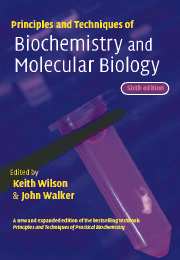Book contents
- Frontmatter
- Contents
- Preface to the sixth edition
- List of contributors
- List of abbreviations
- 1 Basic principles
- 2 Cell culture techniques
- 3 Centrifugation
- 4 Microscopy
- 5 Molecular biology, bioinformatics and basic techniques
- 6 Recombinant DNA and genetic analysis
- 7 Immunochemical techniques
- 8 Protein structure, purification, characterisation and function analysis
- 9 Mass spectrometric techniques
- 10 Electrophoretic techniques
- 11 Chromatographic techniques
- 12 Spectroscopic techniques: I Atomic and molecular electronic spectroscopy
- 13 Spectroscopic techniques: II Vibrational spectroscopy and electron and nuclear spin orientation in magnetic fields
- 14 Radioisotope techniques
- 15 Enzymes
- 16 Cell membrane receptors
- Index
- Plate sections
6 - Recombinant DNA and genetic analysis
Published online by Cambridge University Press: 05 June 2012
- Frontmatter
- Contents
- Preface to the sixth edition
- List of contributors
- List of abbreviations
- 1 Basic principles
- 2 Cell culture techniques
- 3 Centrifugation
- 4 Microscopy
- 5 Molecular biology, bioinformatics and basic techniques
- 6 Recombinant DNA and genetic analysis
- 7 Immunochemical techniques
- 8 Protein structure, purification, characterisation and function analysis
- 9 Mass spectrometric techniques
- 10 Electrophoretic techniques
- 11 Chromatographic techniques
- 12 Spectroscopic techniques: I Atomic and molecular electronic spectroscopy
- 13 Spectroscopic techniques: II Vibrational spectroscopy and electron and nuclear spin orientation in magnetic fields
- 14 Radioisotope techniques
- 15 Enzymes
- 16 Cell membrane receptors
- Index
- Plate sections
Summary
INTRODUCTION
The genomics era has provided a new approach to understanding and discovering biological processes. Indeed the many genome mapping and sequencing projects completed or under way now require new methods of analysis such as automated microarray technology and bioinformatics. New areas have recently been developed, such as pharmacogenomics, metabolomics and systems biology, all of which aim to analyse large numbers of samples simultaneously. This type of massive parallel analysis is set to be the main driving force of discovery and analysis in the coming years. However, developing techniques of molecular biology and genetic analysis have their foundations in methods developed decades ago. One of the main cornerstones on which molecular biology analysis was developed was the discovery of restriction endonucleases in the early 1970s, which led not only to the possibility of analysing DNA more effectively but also to the ability to cut different DNA molecules so that they could later be joined together to create new recombinant DNA fragments. The newly created DNA molecules heralded a new era in the manipulation, analysis and exploitation of biological molecules. This process, termed gene cloning, has led to numerous discoveries and insights into gene structure, function and regulation. Since their initial use, methods for the production of gene libraries have been steadily refined and developed. Although the polymerase chain reaction (PCR; Section 5.10) has provided shortcuts to gene analysis, there are stillmany cases where gene cloning methods are not only useful but an absolute requirement.
- Type
- Chapter
- Information
- Principles and Techniques of Biochemistry and Molecular Biology , pp. 225 - 291Publisher: Cambridge University PressPrint publication year: 2005



